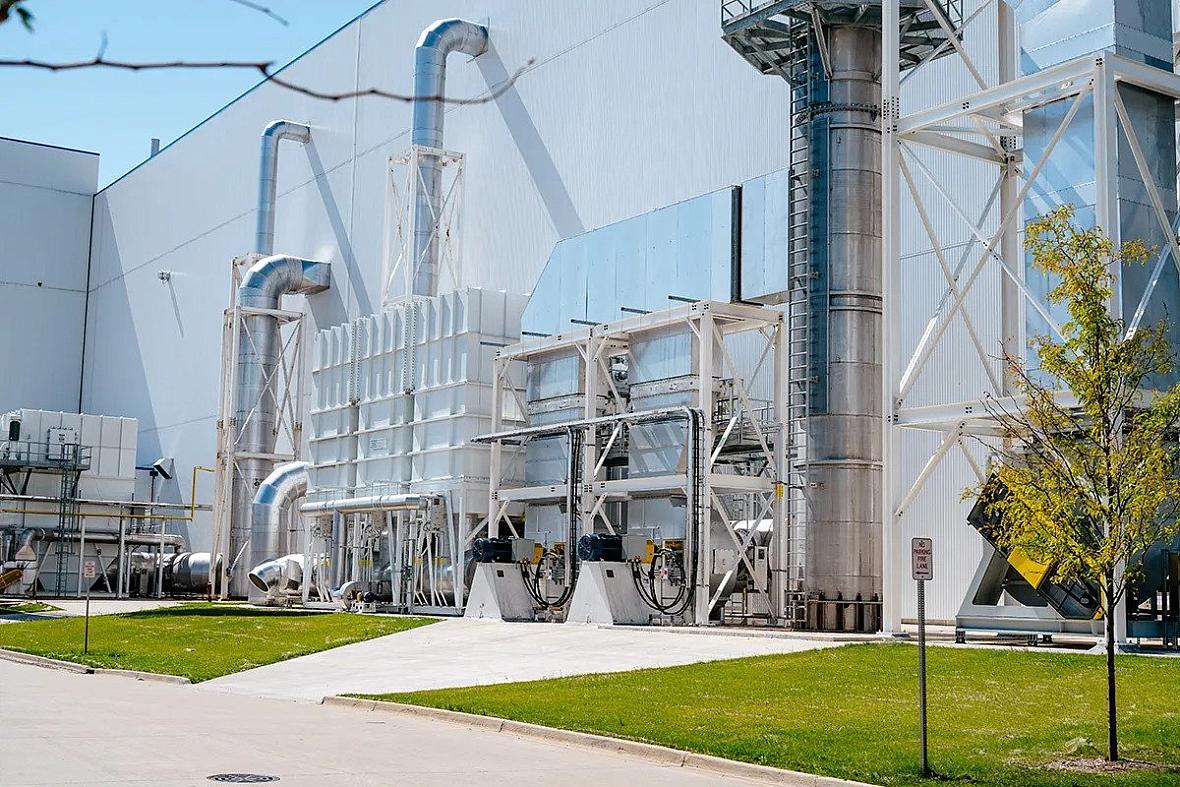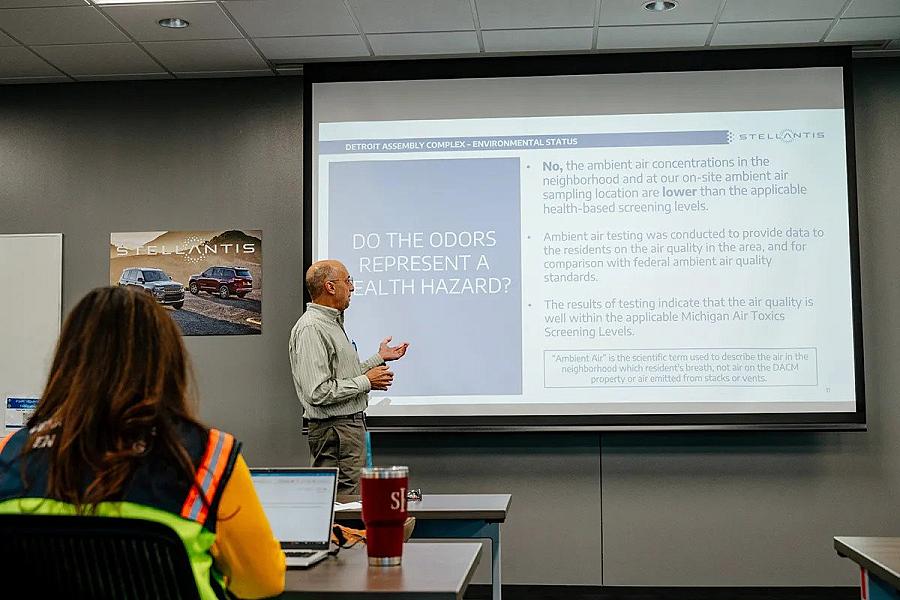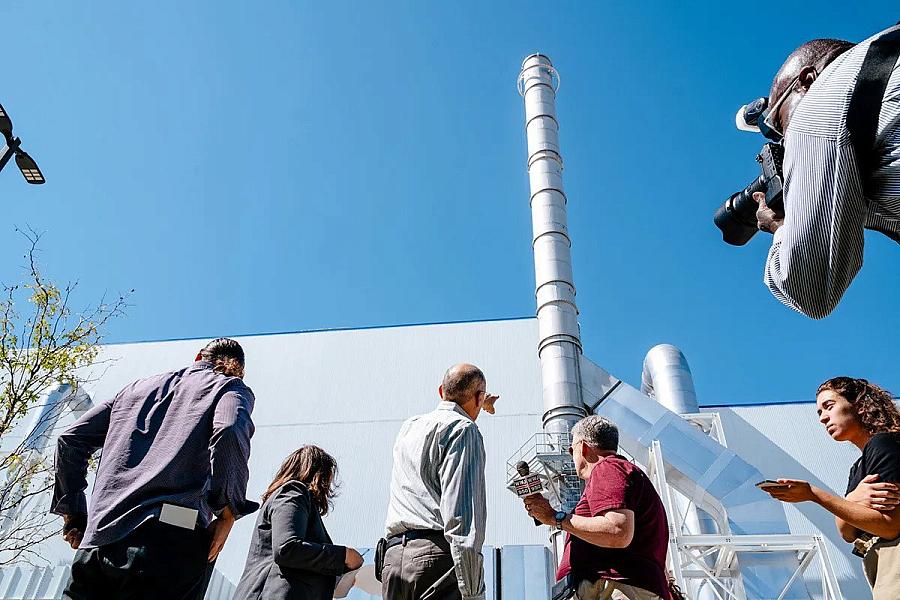Stellantis: ‘There was never a problem with the air’
This story was originally published in Bridge Detroit with support from our 2022 Data Fellowship.

The Mack Factory's second regenerative thermal oxidizer (RTO) sits directly to the right of the factory's first. The equipment, which works to destroy harmful volatile organic compounds with heat, photographed during an August 31, 2023, media tour.
(Photo by Nick Hagen)
Stellantis says new pollution control technology installed to address odors at its Mack plant is working as designed, and the facility has never posed a health risk – despite more than a hundred complaints and eight air quality violations.
The highly anticipated equipment was touted as the solution to odors residents have complained of since the plant first opened in 2021. It was installed as a part of an enforcement order from the Michigan Department of Environment, Great Lakes, and Energy (EGLE) meant to curb future odor violations. Construction on the regenerative thermal oxidizer (RTO), which destroys harmful volatile organic compounds with heat, began in December and it was fully operational at the end of June.
“We have noticed an improvement and we’re very confident that that was a very effective solution to the issue,” Al Johnston, a corporate environmental manager told reporters last Thursday during a presentation meant to give the media updates about the environmental pollution controls at Stellantis.

Al Johnston, senior manager for corporate environmental programs for Stellantis, presents findings suggesting the odors coming from the Mack plant aren’t harmful to residents during an August 31, 2023, press event to discuss a second regenerative thermal oxidizer (RTO)
Photo by Nick Hagen
The presentation, given by Johnston, Detroit Assembly Complex plant manager James Gholston, and senior manager of external affairs Ron Stallworth also provided an overview of the plant and hiring updates. After the presentation, members of the media were taken outside to see the new oxidizer as well as the original one built when the plant was constructed.
Earlier the same day, two more odor complaints were filed with the state, Jill Greenberg, spokesperson for EGLE said.
Of the six complaints filed prior to Thursday, EGLE documented that an inspector noticed a light paint smell during a July 12 check, but a violation was not issued.
Beniteau Street resident Robert Shobe said he’s called at least four times since the equipment was installed due to paint odors.
“They’re trying to say there’s nothing happening here,” Shobe said about Stellantis. “It’s truly time for Stellantis, the city of Detroit, and EGLE to stop hiding behind policy and procedure and take care of the people instead of looking out for corporations.”
Johnston said that since the installation of the second RTO EGLE has “not confirmed any odor complaints, so that is a very positive outcome.” He said company personnel also do their own odor checks twice per shift by walking the perimeter of the property and have not observed any odors.
Johnston claimed Thursday that testing done by the United States Environmental Protection Agency, Michigan Department of Health and Human Services, EGLE, and the city of Detroit shows that the air around Stellantis was never a problem.
Johnston said testing and odor checks support the company’s position that “there was never a problem with the air in the community,” he said.
However, ongoing complaints regarding the odors prompted the Detroit City Council to pass a resolution in February urging the city or state to offer buyouts for residents living near the factory to help them relocate. Councilwoman Latisha Johnson expressed concern about having residents living so close to the factory, and uncertainty over whether the second RTO would really address the issues.
An EGLE official said Tuesday that the department has done “quite a bit” of on-site and stack emissions testing and complaint investigations.
“We’ve never collected any pollutants that would cause us to take immediate action to address air toxics of concern,” said Chris Ethridge, assistant division director for EGLE’s Air Quality Division.
Ethridge also confirmed that the presence of an odor isn’t an automatic violation.
“We understand the frustration of people still smelling paint odors. But under Michigan law, a nuisance odor that we can cite has to reach a certain threshold,” Ethridge said. “The presence of odors in and of themselves is not a violation.”
Michigan law states that odors must cause injurious effects or unreasonable interference with the comfortable enjoyment of life and property to be a violation.

Al Johnston points at the new RTO during a press event.
Photo by Nick Hagen
Between July 7, 2021, and July 5, 2022, EGLE received 95 complaints regarding odors around Stellantis, according to EGLE data provided to BridgeDetroit, resulting in five violations. The Environmental Protection Agency also received 10 complaints, according to records obtained via a Freedom of Information Act request.
“We didn’t expect that very low level of VOCs (volatile organic compounds) would contribute to odors like it did,” said Johnston, adding that the company has remained in compliance with its air quality permit despite the odor complaints.
On November 14, 2022, however, Stellantis was cited for emitting more VOCs than permitted. VOCs are released in the painting process at the plant. Exposure to the vapors can cause eye, nose, and throat irritation, headaches, and nauseas.
To address the odors more quickly, EGLE allowed Stellantis to install the new RTO despite the air permit for the oxidizer still pending.
“It’s a bit unorthodox,” Ethridge said. “But this is what we decided to do to try to reduce the odor issues.”
Last year, Stellantis originally requested to more than double one of its emissions, particulate matter, in the permit to install the second RTO. Exposure to particle pollution has been linked to premature death in people with heart or lung disease, heart complications, aggravated asthma, and more. Between July 7, 2021, and July 5, 2022, EGLE received 95 complaints regarding odors around Stellantis, according to EGLE data provided to BridgeDetroit, resulting in five violations. The Environmental Protection Agency also received 10 complaints, according to records obtained via a Freedom of Information Act request.
“We didn’t expect that very low level of VOCs (volatile organic compounds) would contribute to odors like it did,” said Johnston, adding that the company has remained in compliance with its air quality permit despite the odor complaints.
On November 14, 2022, however, Stellantis was cited for emitting more VOCs than permitted. VOCs are released in the painting process at the plant. Exposure to the vapors can cause eye, nose, and throat irritation, headaches, and nauseas.
To address the odors more quickly, EGLE allowed Stellantis to install the new RTO despite the air permit for the oxidizer still pending.
“It’s a bit unorthodox,” Ethridge said. “But this is what we decided to do to try to reduce the odor issues.”
Last year, Stellantis originally requested to more than double one of its emissions, particulate matter, in the permit to install the second RTO. Exposure to particle pollution has been linked to premature death in people with heart or lung disease, heart complications, aggravated asthma, and more.

Stellantis officials gave a media presentation and tour of new pollution controls outside the Mack plant on August 31, 2023.
Photo by Nick Hagen
Operating the RTO releases particulate matter, but Stellantis requested a 218% increase of its emissions, 36% of which was unrelated to the installation of the thermal oxidizer.
Ethridge said after pushback from EGLE, Stellantis is solely requesting to increase the particulate matter emissions necessary for the operation of the second RTO.
EGLE said it’s “a ways off” from reaching a final agreement on the permit with Stellantis.
“We’re continuing to monitor the situation,” Ethridge said. “We’re having conversations with the company about verification with the community that RTO number two is operating properly. There’s additional things we’re still considering, but we continue to respond to complaints and try to be as proactive as possible with the community.”

